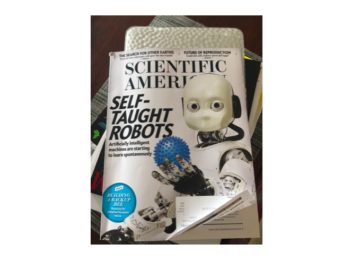Artist Ofri Cnaani’s Frequently Asked in Inhotim, Brazil
BY PAKSY PLACKIS-CHENG
impactmania visits with artist Ofri Cnaani in her Brooklyn, New York studio before her art performances take her to Israel and Finland.
Ofri Cnaani has developed an inclusive way to inspire and educate museum goers and museum staff alike. In Frequently Asked she provides a glimpse of how she worked to deliver a deeper experience of The Inhotim Institute, Brazil.
Transcript of video interview: Frequently Asked.
Ofri Cnaani: I was invited to Inhotim Institute in Brazil, which is a big collection institution in Minas Gerais, two hours from Belo Horizonte. It’s a very famous botanical collection as well as contemporary art collection. When I first visited there, I thought there is another collection here, which is a collection of people — about 1,000 people work there.

The Centro de Arte Contemporânea Inhotim is a contemporary art museum in Brazil.
I was interested in a group that is part of the institutional knowledge, but also excluded. I chose to work with the gardeners. The gardeners worked there for 10 years of the institutions life. They are experts on many different techniques and kind of more pretty industrial techniques of gardening.

Ofri Cnaani with gardener. Photo by William Gomes.
At the same time, many of them never walk into the galleries. And about 40 percent of them are illiterate. But they have knowledge — social knowledge. Some of them are like family members possessing historical knowledge about what was in this area before Inhotim. And, of course, their knowledge about the botanical collection is incredible.

Gardeners and maintenance personnel at Inhotim. Photo by William Gomes.
I invited gardeners and maintenance employees. We walked in Inhotim and then they had the chance to view the performance. One guest came up to me and said, “I am here today with guests. I’ve been here quite a few times before and this is such a gift, because I would never see it from the perspective of someone like this gardener.” I said, “You also gave him a great gift.” Because I never heard this gardener Sergio saying more than two word sentences before. He was empowered, sometimes almost forced, [laughs] but he was there and interested to lead the tour, to mediate, to invite you to see this institution through his eyes was a great gift for him as well.
What do you think is needed for social change?
If you look at the museum as site or as arena, museums are obviously heavy institutions. If they want to introduce a new app… instead of the audio guide, they would hire a company, conduct research, and spend two years in development. Sometimes I look at this and think where are the artists in this story? Artists can be agents of change.

Gardener turned museum guide. Photo by William Gomes.
Maybe it won’t be like the app that covers the entire collection. Maybe it will be a two-week performance or a much simpler app that works on a very specific segment of the collection. If you work with artists, you can have different views — ten different artists and ideas that are more ad hoc or more guerrilla. It’s not showing everything when it tells the story… but then you have ten different stories and different perspectives and different lenses. This potential is for artists to act in the museum as not only maker of more objects, but as interpreter, as the one who re-contextualizes, as the one who connects. And the object as the expert, super expert, alter expert, under expert, is such a strong tool to activate the system and form social to historical and even political meanings.
See here for Ofri Cnaani’s other work: Command & Duplicate.
Ofri Cnaani is an artist and educator. She works in time-based media, live-cinema performances, and large-scale installations. She also teaches at the School of Visual Arts and International Center of Photography (ICP) in New York.
Born in Israel in 1975, Ofri has exhibited and performed at the Metropolitan Museum of Art,PS1/MoMA, BMW Guggenheim Lab, USC Fisher Museum of Art, Moscow Bienniale, Kunsthalle Wien, and Arnolfini.
Select permanent collections include The Israel Museum, Haifa Museum, the Panza Collection, and she has been commissioned by The Metropolitan Museum, and The Inhotim Institute in Brazil to create new original work.
Interview & video by Paksy Plackis-Cheng. Video Editing by Studio Cine, Ian Mayta. In Frequently Asked, photographs by William Gomes.




